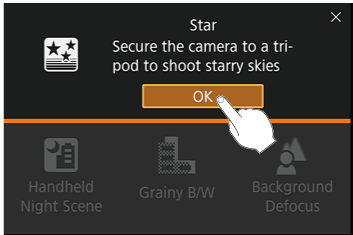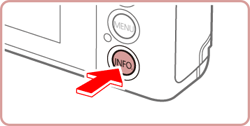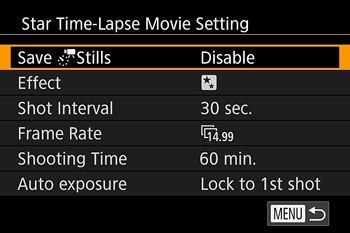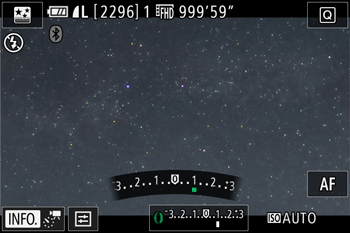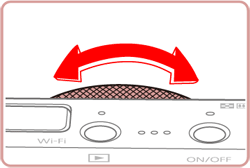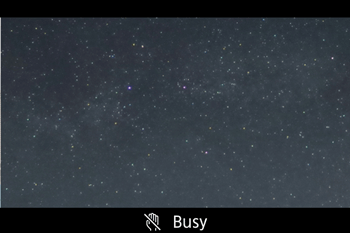Solution
By recording a time-lapse movie that combines images shot at a specified interval, you can create movies with fast-moving stars.
You can adjust the shooting interval and recording duration as needed. Note that each session takes a long time, and requires many shots. Check the battery level and memory card space in advance.
The procedure for shooting start time-lapse movies is explained below.
1.Turn the camera on.
2.Enter [SCN] mode.
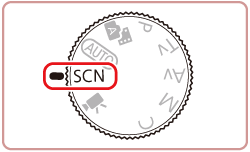
3.Choose a shooting mode.
 ], and then touch [
], and then touch [  ][
][  ] or drag up or down on the screen to choose a shooting mode.
] or drag up or down on the screen to choose a shooting mode.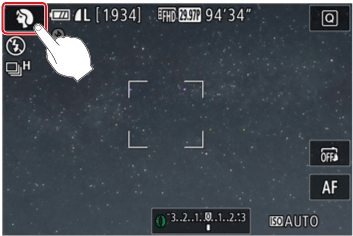

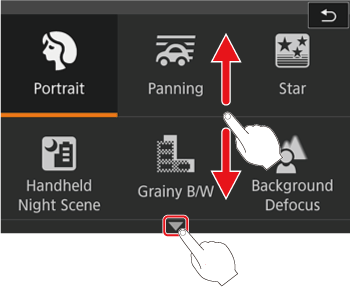
Caution
 ] will be displayed.
] will be displayed.4.Choose [ 
 ], and then press the [INFO.] button.
], and then press the [INFO.] button.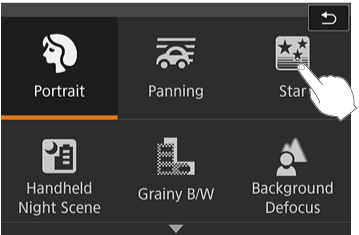

 ], and then press the [
], and then press the [  ] button.
] button.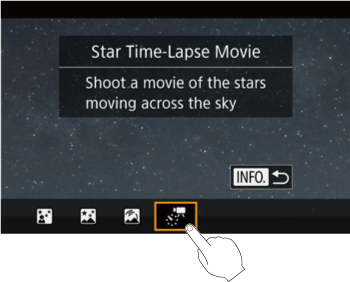
Caution
5.Configure movie settings.
 ].
].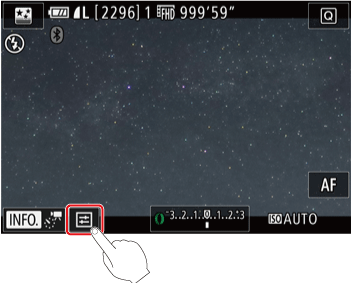
 ⋗ button.
⋗ button.The options that can be configured in [Start Time-lapse Movie] mode are shown in the table below.
| Item | Options | Details |
Save  Stills Stills | Enable, Disable | You can choose to save each shot collected before the movie is created. Note that when [Enable] is selected, [Effect] is not available. |
| Effect |      | Choose movie effects, such as star trail. |
| Shot Interval | 15 sec., 30 sec., 1 min. | Choose the interval between each shot. |
| Frame Rate |   (NTSC) (NTSC)  (PAL) (PAL) | Choose the movie frame rate. |
| Shooting Time | 60 min., 90 min., 120 min., Unlimited | Choose the length of the recording session. To record until the battery runs out, choose [Unlimited]. |
| Auto exposure | Lock to 1st shot, For each shot | Choose whether exposure is determined by the first shot or adjusted for each shot. |
Estimated playback time based on shooting interval and frame rate (for a one-hour session)
| Interval between Shots | Frame Rate | Playback Time | |
| NTSC | PAL | ||
| 15 sec. |  |  | 16 sec. |
| 15 sec. |  |  | 8 sec. |
| 30 sec. |  |  | 8 sec. |
| 30 sec. |  |  | 4 sec. |
| 1 min. |  |  | 4 sec. |
| 1 min. |  |  | 2 sec. |
Caution
 ], [
], [  ], [
], [  ], or [
], or [  ].
].6.Secure the camera.
7.Check the brightness.
 ] ring on the shooting screen and change the exposure level. Check brightness again by taking another shot.
] ring on the shooting screen and change the exposure level. Check brightness again by taking another shot.8.Shoot.
Caution
Caution
 -2 ] tab ⋗ [Night Display] ⋗ [On] before shooting.
-2 ] tab ⋗ [Night Display] ⋗ [On] before shooting.  -6 ] tab ⋗ [Star Time-Lapse Movie Setting].
-6 ] tab ⋗ [Star Time-Lapse Movie Setting].  Stills] set to [Enable] are managed as a single group, and during playback, only the first image is displayed. To indicate that the image is part of a group, [
Stills] set to [Enable] are managed as a single group, and during playback, only the first image is displayed. To indicate that the image is part of a group, [  ] is displayed in the upper left of the screen. If you erase a grouped image, all images in the group are also erased. Be careful when erasing images.
] is displayed in the upper left of the screen. If you erase a grouped image, all images in the group are also erased. Be careful when erasing images.This concludes the explanation of shooting start time-lapse movies.






